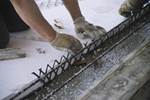KU researchers explore FRP materials for dams, levee reinforcement
To address aging infrastructure, a team of researchers at KU is conducting research into repairing and retrofitting 700-plus dams, levees and related structures nationwide using FRP materials.

University of Kansas School of Engineering (Lawrence, Kan., U.S.) researchers are partnering with U.S. federal agencies in efforts to reinforce dams and levees across the U.S. using fiber-reinforced polymers, sensors, artificial intelligence and drones.
The five-year, $7.7 million project is a partnership between KU, the U.S. Army Engineer Research and Development Center (ERDC), the Department of Homeland Security’s Science and Technology Directorate and the U.S. Army Corps of Engineers (USACE).
The KU team of researchers is led by Caroline Bennett, Dean R. and Florence W. Frisbie Associate Chair of Graduate Studies, Glenn L. Parker Faculty Fellow and professor of civil, environmental and architectural engineering.
“The project focuses on developing repairs and retrofits for the inventory of concrete dams in the U.S., with an emphasis on efficient damage detection,” Bennett says. “In addition to repair methods, we’ll be using fiber-reinforced polymer materials, or FRPs, to address damage. Specifically, we’re targeting sliding at lift joints, restraining rocking between crest block and dam body during seismic loading, and damage on concrete spillways of dams. Our goal is to extend the usable lives of existing concrete dam infrastructure, which was mostly built in the 1930s and 1940s.”
Several of the dams and levees from this era have experienced catastrophic failures in recent years due to disrepair. A recent assessment concluded the nation’s dams and levees require $93.6 billion in upgrades to many of the 700-plus dams and related structures the USACE operates and maintains.
KU researchers are exploring new, safer approaches for assessing dam and levee damage, which traditionally required manual inspection. The team’s approach will rely on artificial intelligence, according to co-primary investigator Jian Li, Francis M. Thomas Chair’s Council associate professor of civil, environmental and architectural engineering at KU.
“My main role is focused on using deep learning and computer vision to autonomously identify the location and severity of dam damage, such as concrete cracking and spalling, for which FRP repair is needed,” Li explains. “Once the repair is done, these locations are no longer inspectable. Therefore, we’ll also develop self-sensing FRP repairs to enable continued monitoring of the repaired regions to ensure long-term safety. By leveraging emerging technologies including artificial intelligence, computer vision and advanced sensing, our research will greatly enhance timely repair, retrofit and maintenance of the nation’s large inventory of concrete dams.”
In the meantime, work is underway by KU faculty, postdoctoral researchers, graduate students and undergraduate research assistants to identify fiber-reinforced polymer materials for use in concrete gravity dam applications. Materials characterization and large-scale testing is being performed at three different KU laboratories: the West Campus Structural Testing Facility, the Learned Hall Structural Engineering Testing Laboratory and the Lutz Fracture and Fatigue Laboratory.
Rémy Lequesne, associate professor of civil, environmental and architectural engineering, says, “We’re developing more efficient methods for dam inspection and, through data collection and model development, providing tools that engineers can use to make decisions about whether and how to repair existing dams.”
Lequesne will oversee experimental testing of simulated joints in concrete dams, both with and without repairs. “Results will lead to recommendations and new modeling tools that engineers can use for assessment and design of repairs,” he says.
In addition, KU researchers will conduct a review of all research into FRP materials, with a particular interest in carbon-fiber-reinforced materials, to inform the project.
Related Content
Materials & Processes: Resin matrices for composites
The matrix binds the fiber reinforcement, gives the composite component its shape and determines its surface quality. A composite matrix may be a polymer, ceramic, metal or carbon. Here’s a guide to selection.
Read MoreMaterials & Processes: Fibers for composites
The structural properties of composite materials are derived primarily from the fiber reinforcement. Fiber types, their manufacture, their uses and the end-market applications in which they find most use are described.
Read MoreThe state of recycled carbon fiber
As the need for carbon fiber rises, can recycling fill the gap?
Read MorePEEK vs. PEKK vs. PAEK and continuous compression molding
Suppliers of thermoplastics and carbon fiber chime in regarding PEEK vs. PEKK, and now PAEK, as well as in-situ consolidation — the supply chain for thermoplastic tape composites continues to evolve.
Read MoreRead Next
Composites-reinforced concrete for sustainable data center construction
Metromont’s C-GRID-reinforced insulated precast concrete’s high strength, durability, light weight and ease of installation improve data center performance, construction time and sustainability.
Read MoreOptima 3D demonstrates new 3D weaving technology for ASCC
U.K. company will install compact system with innovative shuttle and digital twin capability for soft and hard composite structures at University of Maine’s new textile lab.
Read MoreFrom the CW Archives: The tale of the thermoplastic cryotank
In 2006, guest columnist Bob Hartunian related the story of his efforts two decades prior, while at McDonnell Douglas, to develop a thermoplastic composite crytank for hydrogen storage. He learned a lot of lessons.
Read More


















.jpg;maxWidth=300;quality=90)







